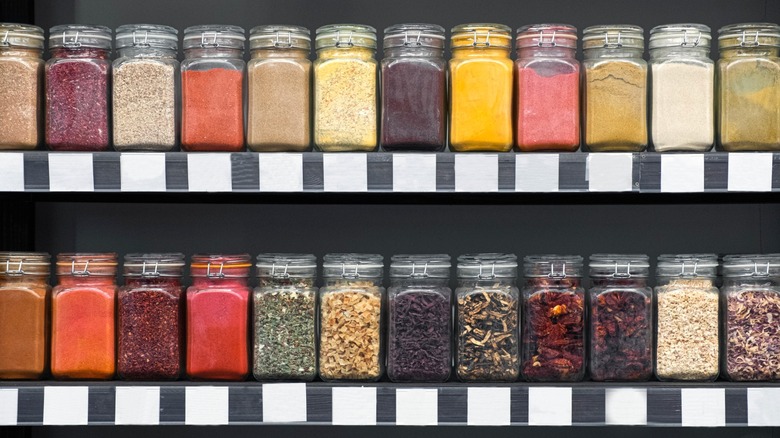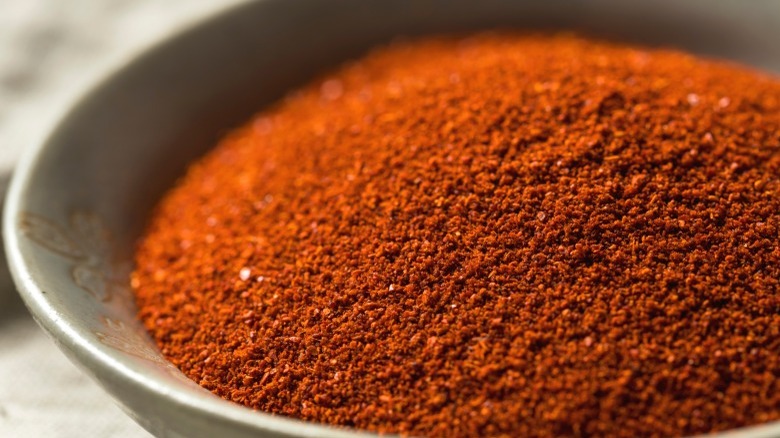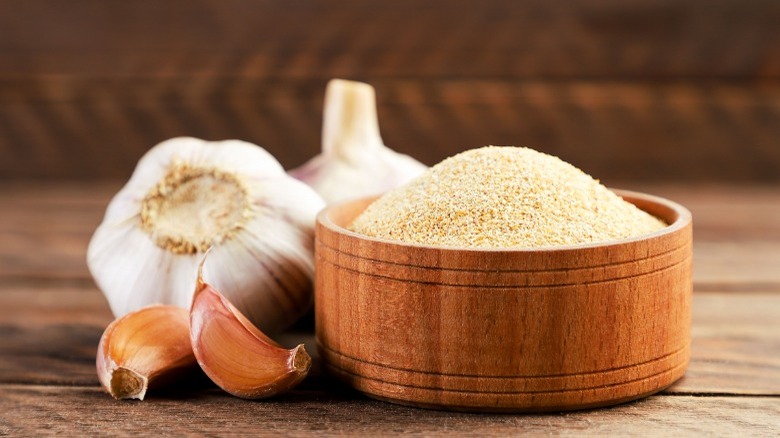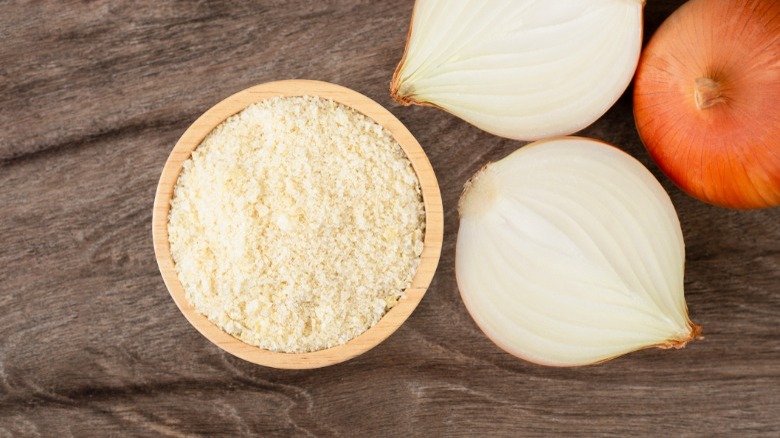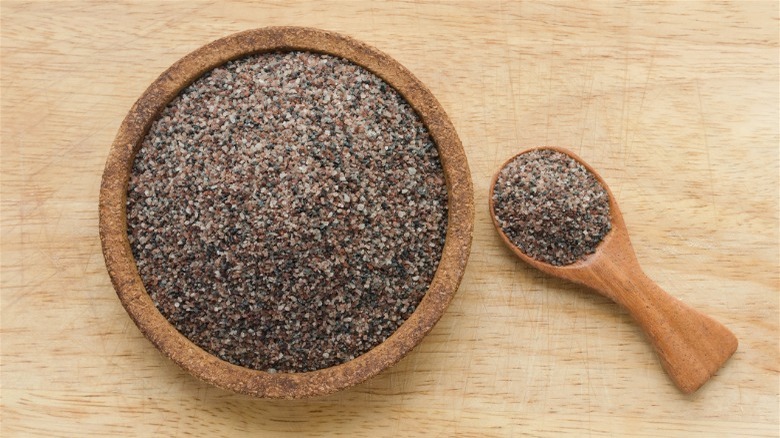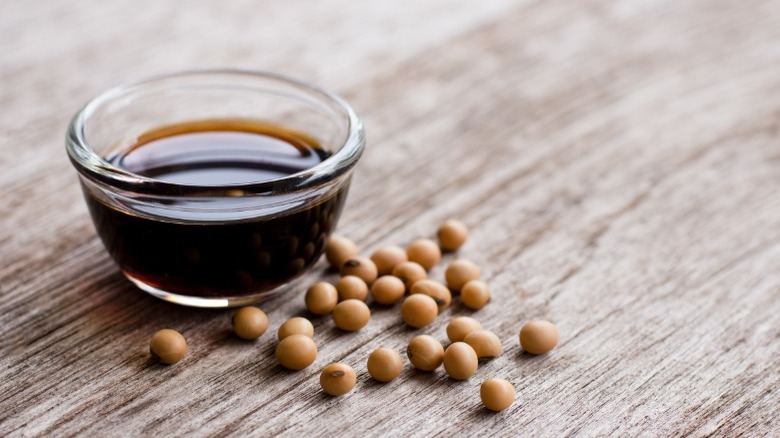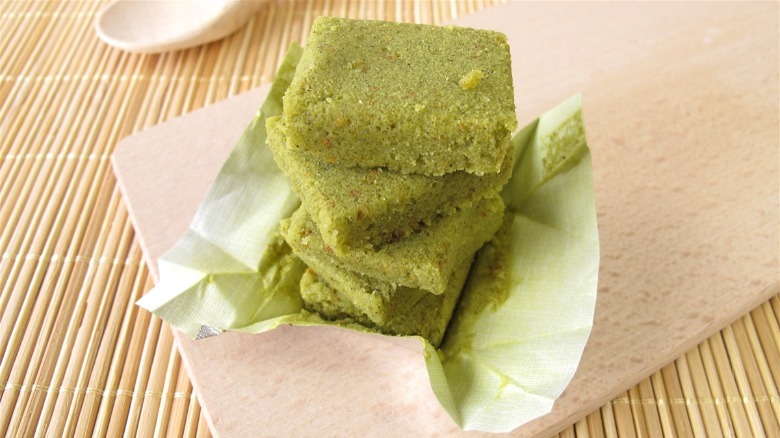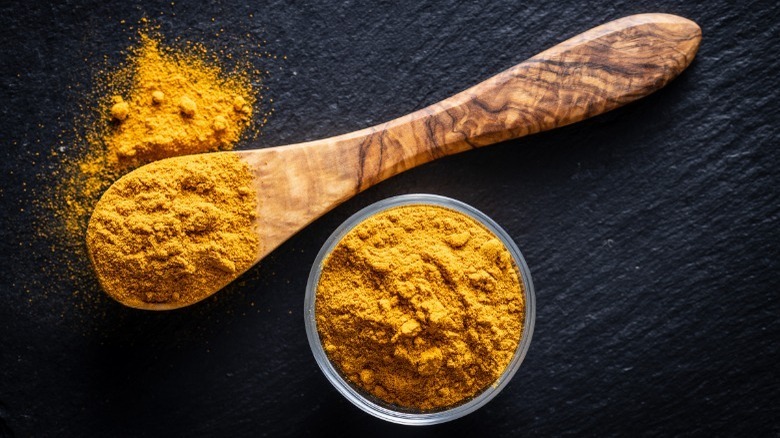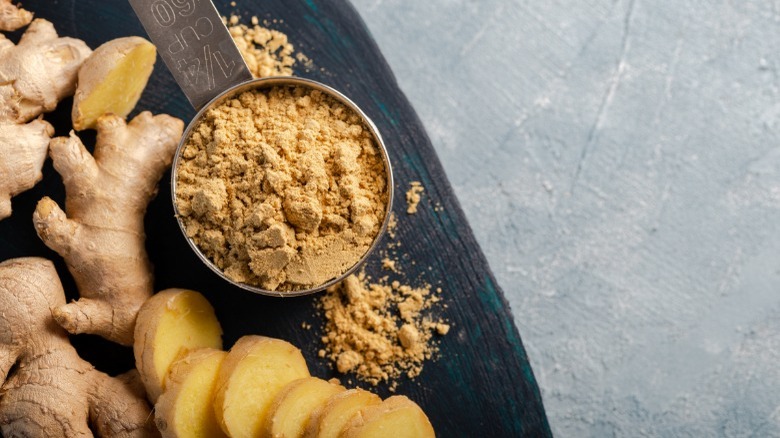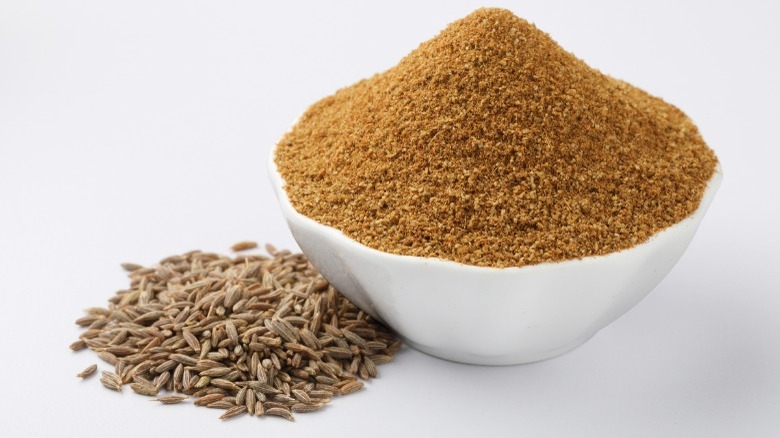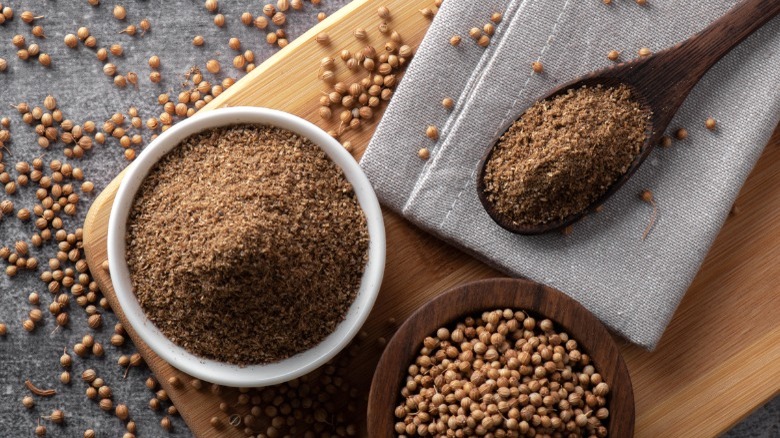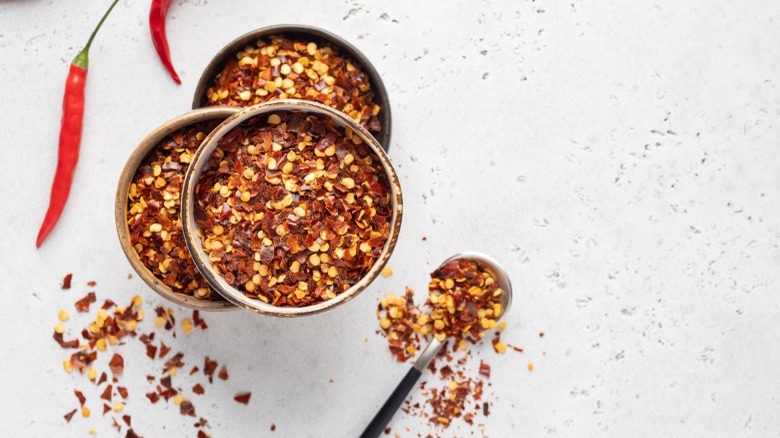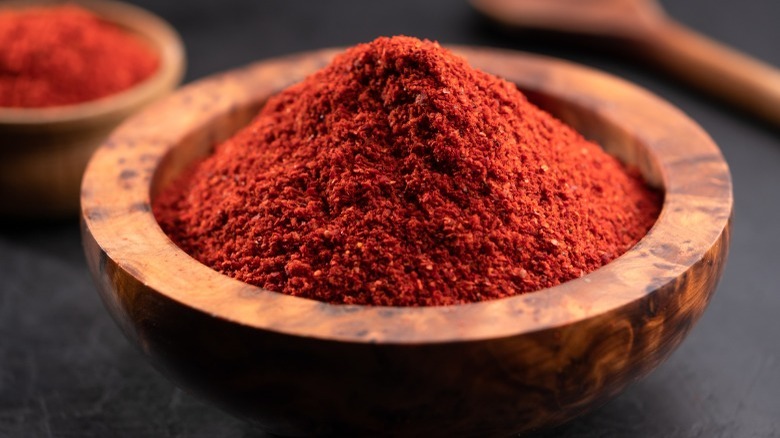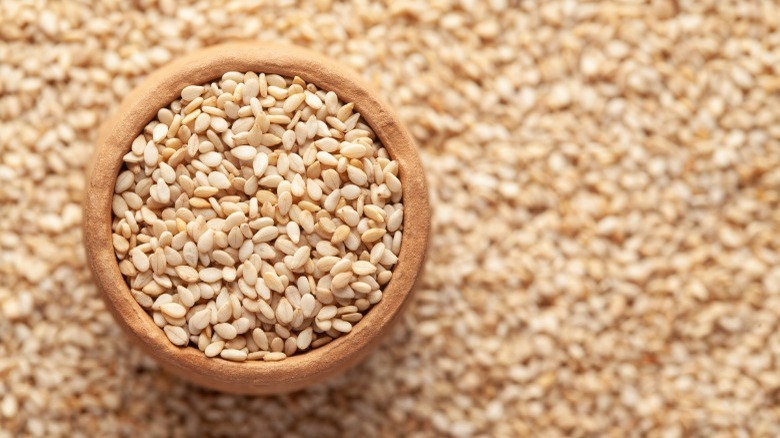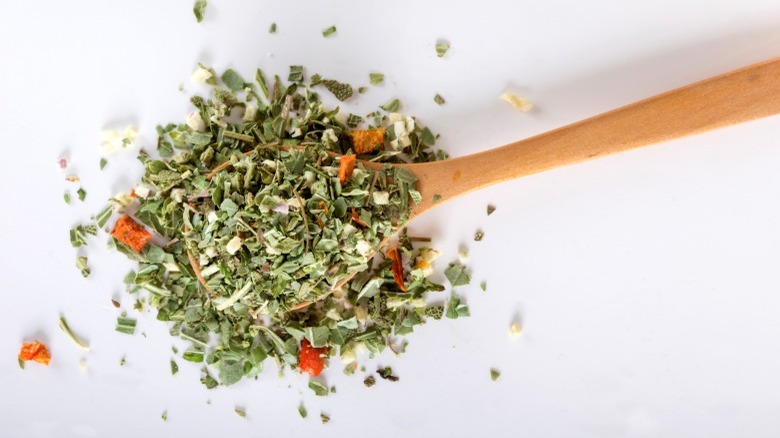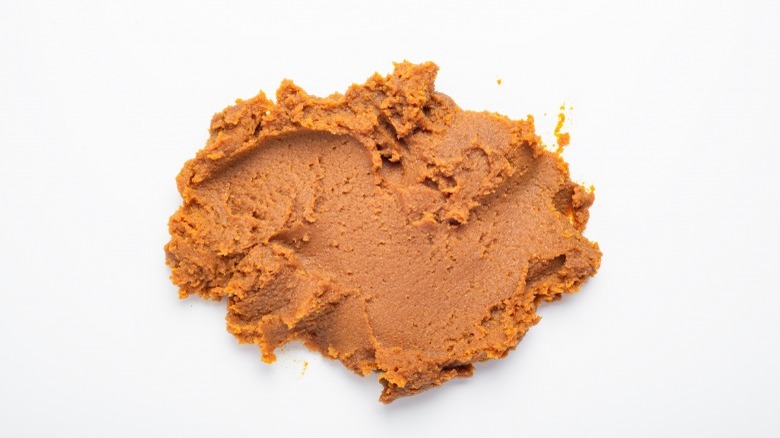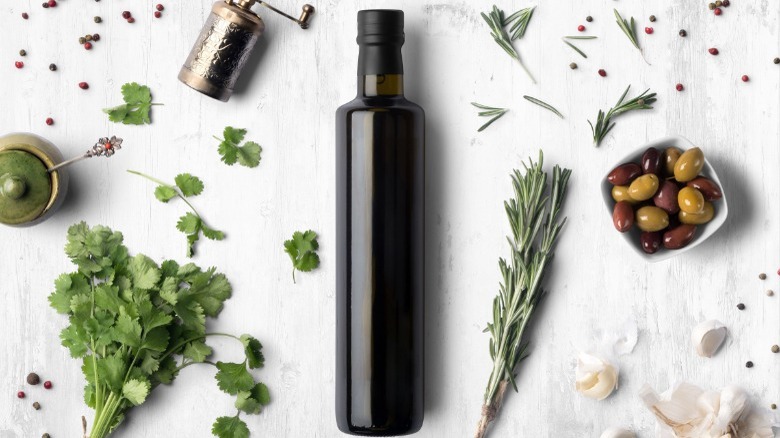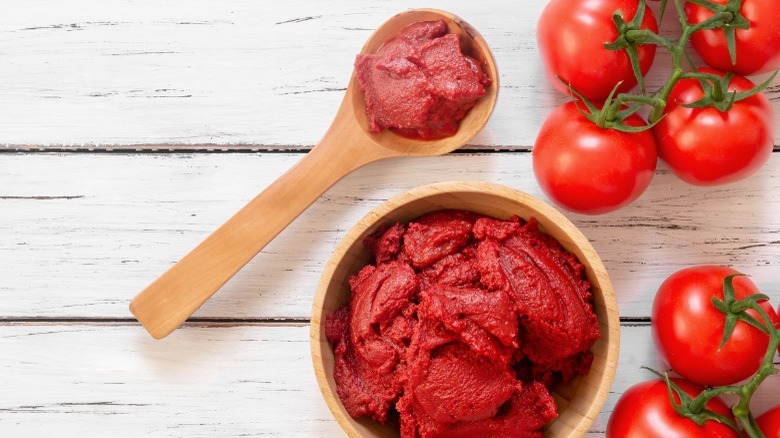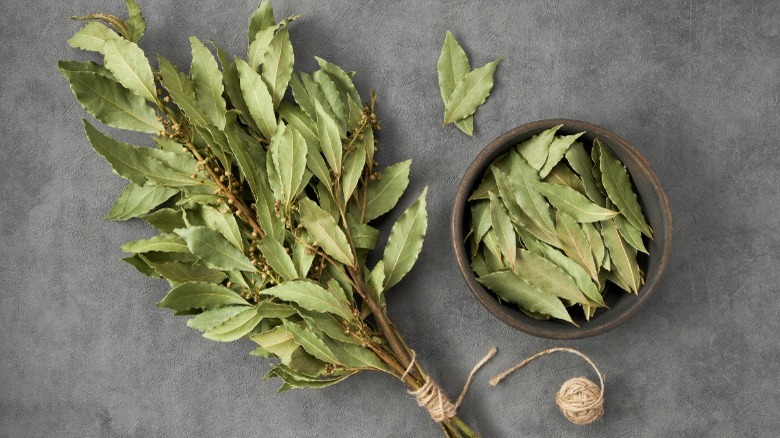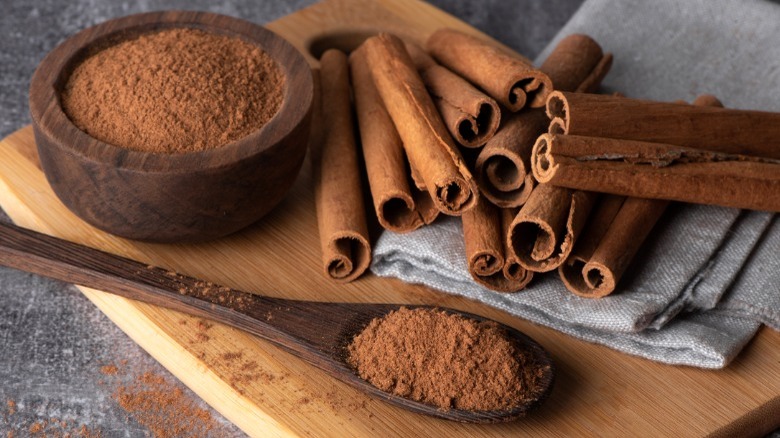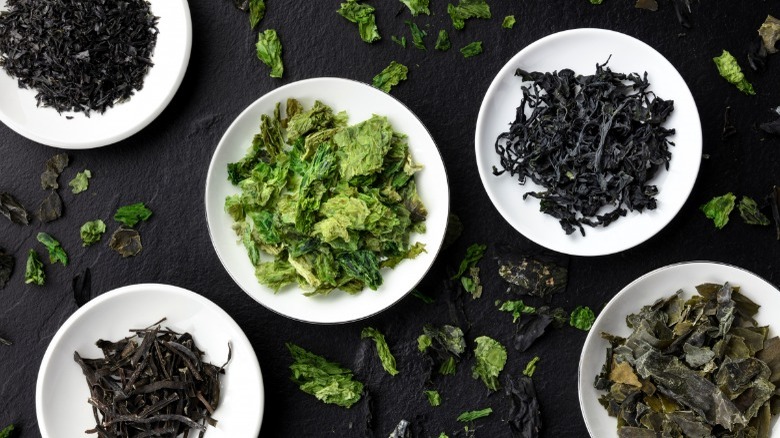22 Seasonings And Spices Every Vegan Should Have On Hand
Whether you're a seasoned vegan or just dabbling in plant-based eating, you know that cooking with plants is a never-ending quest for umami — the rich, savory flavor present in animal foods. Fortunately, there are a number of ways to transform and enhance the flavors of grains, beans, and vegetables. And a knowledgeable use of spices and seasonings is one of them. A wide selection of ingredients ranging from sweet and fragrant to bold and pungent can help you take vegan cooking to the next level and make it your own.
Since your favorite dishes likely already rely on spices and seasonings to achieve bold flavors, veganizing them will be a breeze. From natural flavor boosters such as ginger, garlic, and onion powders, miraculously cheesy nutritional yeast, and aromatic black salt, to umami-packed fermented foods such as soy sauce and miso paste, these ingredients are a must-have in a well-stocked vegan kitchen.
Smoked paprika
While there are several varieties of paprika out there, smoked paprika is a popular standout when it comes to plant-based cooking. It's made from smoke-dried chili peppers and is known for its rich flavor and red color. Any seasoned vegan will tell you that smoked paprika is a go-to ingredient for hearty, "meaty" dishes, as it imparts that rich, smoky flavor often associated with cooked meat. Of course, you can also use it to make your vegetable dishes pop because it offers just the right amount of umami. Smoked paprika is also a delicious addition to vegan chili and soups and can be used as a rub for grilled tofu or tempeh. Finally, if added to spice blends and marinades, it can add more dimension to plant-based meals.
Nutritional yeast
Though originating in the same family, nutritional yeast is not to be confused with baker's and brewer's yeast. Sold as yellowish flakes, it is deactivated, meaning its purpose isn't to jump-start fermentation but rather to impart a cheesy, nutty, and savory flavor to dishes. Nooch, as it's informally known, is also rich in B vitamins and a complete protein, making it a welcome addition to a vegan diet (via WebMD).
Nutritional yeast is the secret ingredient in cashew cheese and any number of cheesy plant-based dishes that require that particular savory flavor. Some other delicious ways to use nutritional yeast include creamy pasta dishes, soups, dips, and bread. Whether sprinkled on top of popcorn or blended into a cheesy sauce, nutritional yeast is a necessary addition to any vegan pantry.
Garlic powder
Garlic, in all its forms, is known to add a flavor punch to any savory dish. However, powdered garlic is often favored in plant-based cooking, as its pungent, slightly sweet, and earthy flavor is more subtle, and its soluble consistency makes it more versatile. It works wonders on vegetables, in sauces and dressings, as well as in soups and stews.
To enhance the flavor of vegan dishes, simply sprinkling garlic powder to taste is enough. However, there is a garlic powder hack that will help you maximize its flavor: Instead of throwing it straight into the pan, rehydrate it first. This will activate the alliinase enzyme responsible for the signature flavor. You can also use it in place of salt to add a savory taste to meals while reducing sodium intake.
Onion powder
Onion powder is a flavor-packed seasoning that lacks the sharp pungency of fresh onions. It is believed that it has been around for ages, most likely originating in the Middle East, where it was used as a method of preserving onions (via Spiceography). Today, it is often used as a substitute for fresh onions in recipes where fresh onions might overpower the dish.
Plant-based cuisine capitalizes on its flavor powers by including it in stews, marinades, dressings, and anything else that needs an extra burst of flavor. Onion powder is also a great way to enhance the taste of tofu, tempeh, or other plant proteins. It is typically made by finely grinding dehydrated onions, but you can make your own low-waste alternative by washing, drying, and grinding onion skins.
Black salt
Also known as kala namak, black salt is an essential ingredient for plant-based eaters looking to recreate their favorite egg dishes. Native to India, it gets its dark color and distinct flavor from its volcanic origins, as well as the high levels of sulfur compounds. Its low sodium levels make kala namak a healthier table salt alternative, but it's more often used as a flavor enhancer (via WebMD).
In vegan cooking, it's commonly found in recipes for tofu scrambles, chickpea omelets, vegan egg salads, and the like. Black salt can also be sprinkled on top of salads and roasted vegetables to add depth and complexity. However, the strong, sulphuric flavor is an acquired taste, so use a light hand the first few times you're cooking with it.
Liquid smoke
On par with smoked paprika, liquid smoke is a flavor enhancer used to give food a smoky flavor without using actual wood smoke. It's made with by-products of burning wood, which are then condensed into a liquid form. This creates a nostalgic and comforting savory flavor encapsulated in an easy-to-use essence.
In vegan cooking, it's often used to add a smoky taste to proteins, sauces, and marinades. It's the key to making Tabitha Brown's viral carrot bacon, or any other plant-based meat, for that matter. However, it's important to remember that with liquid smoke, a little goes a long way, as it can be overpowering if used in large amounts. When working with it, start with just a few drops and adjust to taste.
Soy sauce
Soy sauce is an essential ingredient in Asian cuisines made from fermented soybeans, wheat, salt, and water. Tamari is one of the types of soy sauce that's made without wheat and is, therefore, gluten-free. There are also alternatives made from other ingredients, such as coconut sap, which can provide a similar taste profile for those who are avoiding soy and wheat products.
In a vegan kitchen, soy sauce provides a convenient way to add umami flavor to dishes, including stir-fries, sauces, and marinades to enhance other flavors. Together with other staples off this list, it can be used as a base for an anchovy-less Worcestershire sauce or a rich vegan stock. Just be mindful of how much you're using, as most commercial varieties are quite high in sodium.
Vegan bouillon cubes
We've all been there: You scan a vegetable coconut curry ingredient list, and among all the veggies and spices, there's always the dreaded cup of vegetable stock. While the healthiest way to go about it is to make your own from veggie scraps and freeze it for such occasions, vegan bouillon cubes will do in a pinch.
Typically made from a combination of vegetable broth, salt, and seasonings, these cubes offer a rich and savory taste that's similar to traditional bouillon but without the use of animal products. In addition to using them directly for broth, they can majorly upgrade your pasta sauce. Alternatively, you can crumble the cubes with tahini and sesame oil to dress chickpeas before baking or stir it into mashed potatoes.
Turmeric
Commonly used in Indian and Middle Eastern cooking, this warm yellow spice is well-known for its anti-inflammatory and antioxidant properties. Its flavor is described as earthy and somewhat bitter. Curcumin, the main compound in turmeric, is fat soluble, meaning it works best when bloomed in oil. Additionally, the spice is often combined with black pepper to increase its absorption in the body (via Healthline).
For vegans, it is a great way to add depth of flavor and a beautiful yellow color to scrambles, soups, curries, sauces, and smoothies. Turmeric is also a key ingredient in golden milk, a warm beverage made with turmeric, ginger, and coconut milk. On hotter days, you could turn it into a golden milk vegan ice cream and enjoy the same health benefits.
Ginger
Together with onion and garlic, ginger rounds up a savory aromatics starter pack that you can rely on to make any dish taste amazing. It has a warm, slightly spicy flavor and is packed with incredible health benefits, used as nausea, inflammation, and bloating remedy, among other things.
When using ginger in vegan cooking, fresh is best, but powdered ginger can be substituted if needed. Both can be used to make delicious stews and curries, as well as desserts. You can also incorporate it into marinades, sauces, and even smoothies for an additional kick. When substituting fresh ginger with powder, it's important to consider that the powder can be much more potent than fresh root. It's best to start with ⅛ to ¼ teaspoon and add more to taste.
Cumin
Cumin, sold in whole seed and powdered form, has an earthy, nutty flavor and a slightly pungent aroma. It is popular in many cuisines, including Mexican, Indian, and Middle Eastern, and is therefore associated with spicy dishes. But how spicy is it, really? On its own, almost not at all. However, its hearty flavor is nevertheless able to add depth to any plant-based dish, even a simple stovetop yellow rice.
Cumin pairs well with other spices, making it a versatile ingredient for vegan cooking. Curries, tacos, and hummus all greatly benefit from it. Mix it with some tahini, lemon juice, and cooking water, and you've got yourself an amazing pasta sauce. Or, make a flavorful cumin-herb sauce that can be used as a dip for buffalo cauliflower or any other plant-based fried "chicken."
Coriander
Coriander has a unique flavor that combines a slight sweetness with a hint of lemon, making it a great addition to both sweet and savory dishes. That's why there are so many delicious ways to use coriander seeds in your cooking. Whole coriander is often added to marinades, bread, and pickles, whereas ground coriander is great for sweet bakes and sauces.
In Indian cuisine, coriander is frequently used in spice blends like garam masala and is also a key ingredient in dhals and biryanis. Middle Eastern dishes like hummus, falafel, and tabbouleh often feature ground coriander seeds. In North African cuisine, coriander seeds are used in spice blends like berbere or dukkah and add flavor to dishes like tagines and couscous. Incidentally, most of these dishes are already vegan-friendly.
Red pepper flakes
Sometimes referred to as crushed pepper, red pepper flakes can be made from one or more red pepper varieties. Their spiciness typically ranges from low to medium. Most blends include seeds, but some, like Korean gochugaru, are made solely from crushed pepper walls.
Use red pepper flakes alongside oil, shallots, toasted sesame seeds, and spices to make an easy homemade chili crisp that will make easily elevate even the plainest rice, tofu, and vegetables. It can also majorly upgrade canned pasta sauce by introducing more texture, color, and heat. Another popular use for red pepper flakes is homemade spicy ketchup or hot sauce. Finally, you can use them to embolden the flavor of vegetables and proteins by adding them to the dry rub or marinade.
Cayenne pepper
While red pepper flakes are necessary to add an appetizing, vibrant element to your dishes, powdered red pepper, such as cayenne, is bound to bring the real heat. It is made from ground, dried cayenne chili peppers and has a pungent, spicy flavor.
Plant-based foods such as soups, stews, sauces, and marinades can majorly benefit from cayenne pepper's heat and flavor. It can also be sprinkled on roasted vegetables or proteins as part of an all-purpose chili seasoning. Additionally, cayenne pepper can be incorporated into smoothies and juices, and if you add it to your morning coffee, you'll never look back. As with any spice, it's important to start with a small amount and adjust to taste, as cayenne pepper can be pretty spicy.
Sesame seeds
Most seeds are rich in vitamins, healthy fats, and other beneficial compounds and are therefore favored in vegan cooking. But with chia and flax seeds reigning over plant-based cooking, sesame seeds are often overlooked. Meanwhile, they boast many health benefits, including lowering blood pressure and cholesterol, as well as high counts of protein, B vitamins, and antioxidants (via Healthline).
It's incredibly easy to incorporate sesame seeds into everyday meals. For example, you can add a nutty, crunchy element to rice, noodles, sandwiches, and curries by sprinkling on some toasted seeds before serving. They also work well as a topping for buns, bread, savory cookies, and other baked goods. Finally, you can make your own tahini — the creamy ground sesame paste that works wonders in sauces, dips, and baked goods.
Italian seasoning
Italian seasoning is a blend of herbs commonly used in the region. It has a warm, earthy flavor and can be used to season many dishes, including soups, sauces, and pasta. As will all spice blends, making your own is a game changer. A classic Italian seasoning recipe is easy to make, as it involves simply mixing dried basil, oregano, thyme, rosemary, and parsley.
Some of the best ways to use Italian seasoning in vegan cooking include enhancing the tomato flavor in soups like tomato soup and minestrone soup, pizza, and pasta sauces. It can also be used to season breadcrumbs for coating plant-based cutlets. Another option is to mix it into olive oil to make a flavored oil for dipping bread or brushing onto a pizza crust.
Miso paste
You might know it as the namesake ingredient of Japanese miso soup, but this thick paste made from fermented soybeans, salt, and koji has a broad culinary potential. It's a salty umami-packed seasoning with a slightly sweet and nutty taste. It can impart a deep savory flavor to sauces, marinades, and vegetables such as mashed potatoes or miso-glazed eggplants. When diluted with warm water, it becomes a flavorful vegan broth that's perfect for risotto and other dishes calling for umami-packed broths, such as vegan miso ramen. While it might seem counterintuitive to some, miso can also make a wonderful addition to sweet dishes in the form of sweet and savory caramel sauce or simply as an add-in for sweet batter or ice cream base.
Vinegar
The versatile acidic liquid we all know and love, vinegar is a staple in most pantries worldwide. There are many different types of cooking vinegar that vary in color, consistency, flavor, and application. Most varieties are derived from plant sources and are suitable for vegan cooking. Still, when it comes to wine, Champagne, and cider vinegar, additional research is sometimes required, as animal products can be used during production.
Vegan-friendly ways to cook with distilled white vinegar include making plant-based buttermilk, meringue, pickles, and hot sauces. Apple cider vinegar is most commonly used in baking, as well as in salad dressings. White wine vinegar can add a tang to a vegan cheese sauce, and rice vinegar is often used in plant-based seafood alternatives, such as carrot lox.
Tomato paste
Unlike most of its fellow seasonings used to amp up the umami in plant-based dishes, tomato paste is on the accessible side. It's inexpensive, sold almost everywhere, and has a rich, concentrated flavor that other tomato products can't match. Moreover, it's so versatile and widely used that you should always keep a can in your pantry, regardless of your diet.
When cooked with other ingredients, tomato paste helps to create a rich flavor profile. However, the proper way to use it is more than simply plopping it into whatever you're making straight out of the can. Instead, you should be browning tomato paste by heating it up with some oil before adding it to a soup, stew, or sauce. Leftover tomato paste can be preserved by dehydrating or freezing.
Bay leaves
Bay leaves are the underdog of aromatics. With their fragrant, slightly bitter taste being quite subtle, they are often overlooked in the spice department. But the dried leaves of the bay laurel tree do their work behind the scenes, working closely with other herbs and spices to enhance the overall flavor of the dish.
For one, they are often used in soups, stews, and sauces to add depth of flavor. According to Reddit, bay leaves positively affect the taste of soup, rice, and chili. This was determined by making batches of these dishes with and without the leaves, resulting in obviously different flavors: The ones containing bay leaf tasted more well-rounded. So the next time you make your favorite soup, throw a couple of leaves in and see the difference they make for yourself.
Cinnamon
Cinnamon, sold in whole and powdered forms, is derived from the inner bark of multiple tree species. It is a fragrant, sweet spice that has a warm, woody flavor with hints of clove and nutmeg. It is believed to have numerous health benefits, which is why some say you should eat cinnamon every day.
Cinnamon's unique flavor can be used to create a number of delicious vegan dishes. For one, it pairs well with drinks and desserts, such as dairy-free hot chocolate and vegan cinnamon rolls. Together with other warm spices, it can be used to add depth and complexity to savory dishes, such as the Moroccan chickpea stew or a cinnamon-laced chili. Finally, cinnamon can be used to season sweet veggies, such as roasted squash or sweet potato, and cooked fruits.
Dried seaweed
Any vegan person with a passion for rich, umami-packed dishes and healthy eating should have various kinds of dried seaweed in their arsenal. For one, some type of seaweed is typically required when making plant-based seafood alternatives at home because it imparts that fishy flavor. Additionally, most of them are rich in iodine, calcium, protein, iron, fiber, and vitamins (via One Green Planet). Agar-agar is commonly used as a thickening and gelling agent in vegan baking. Kombu is used to make vegan-friendly dashi — a Japanese stock typically relying on dried fish for umami. Dulse, hijiki, and wakame can all be reconstituted with water and added to salads, smoothies, and soups. And nori, the one you're likely most familiar with, can be used outside of sushi rolls to make furikake or another flavorful seasoning.
Static Media owns and operates Mashed.
